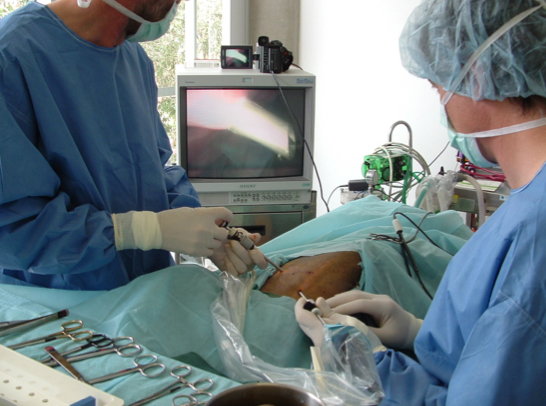North Shore Veterinary Hospital now offers laparoscopic desexing for female dogs. Laparoscopy, or minimally invasive surgery, entails doing the procedure through small incisions using a telescope instead of a large incision. This decreases the size of the wound, the manipulation involved and hence leads to a more comfortable recovery. Laparoscopic surgery is now the norm in human surgery to minimise pain and speed recovery.
We recommend this for female dogs under 1 year of age with a body weight of over 8 kg. In the smaller dogs there is little advantage in the minimally invasive surgery as the incisions using normal surgery are very small anyway.
We now have a “Ligasure”, a special electrocautery device, to ensure safe sealing of the blood vessels to the ovaries. This greatly increases the speed and safety of the procedure.
In large breed dogs such as Great Danes and Rottweillers, gastropexy can be performed during the same procedure with little extra discomfort.
The equipment needed for laparoscopy is very expensive and at present we are charging 50% above the normal cost of desexing for this procedure. Please call the hospital and ask to speak to one of the surgeons about laparoscopic desexing if you are interested in it for your pet.

Laparoscopic surgery, while not faster, means much less trauma and pain. Rather than a 100 to 150 mm incision, we can do the surgery with scopes via 2 5 to 10 mm incisions. Smaller incisions and less traction during surgery will lead to less post-operative pain and quicker recovery. Laparscopic, or minimally invasive surgery, is now commonplace in human surgery.
Laparoscopy involves inflating the abdomen with carbon dioxide to create working space then inserting a portal to enable passing a telescope connected to a television to examine the abdominal contents. Another portal is created to pass in the instruments etc. Laparoscopic or minimally invasive surgery is very commonly used in human surgery for many abdominal procedures such as gall bladder removal.
Laparoscopy can also be used in other procedures such as cystotomy (opening the bladder) for bladder stone removal, crytorchid (retained) testicle removal and biopsy of the liver and other internal organs.
Similar techniques can now also be used for chest surgery to greatly decrease the pain and risk involved.

